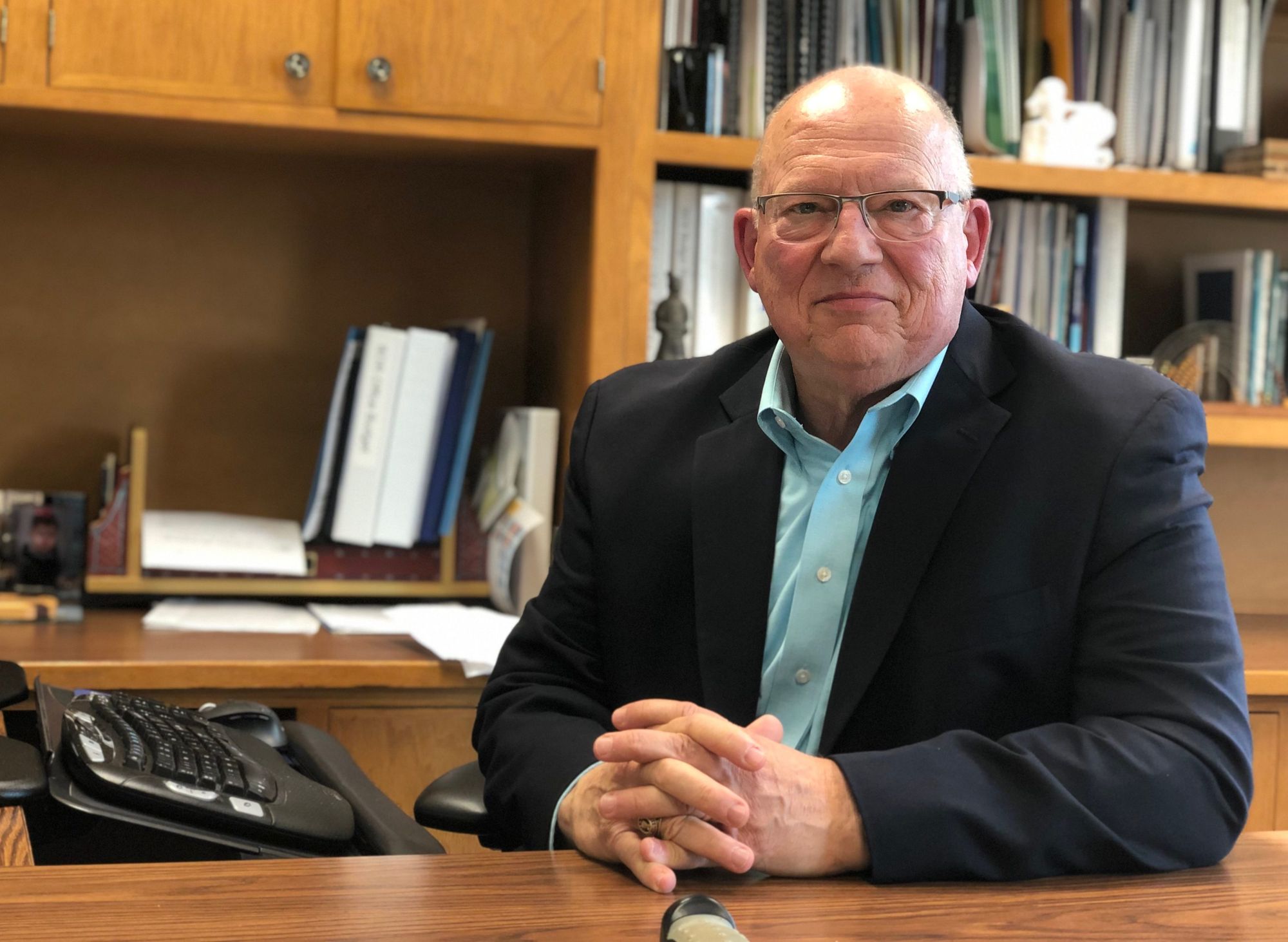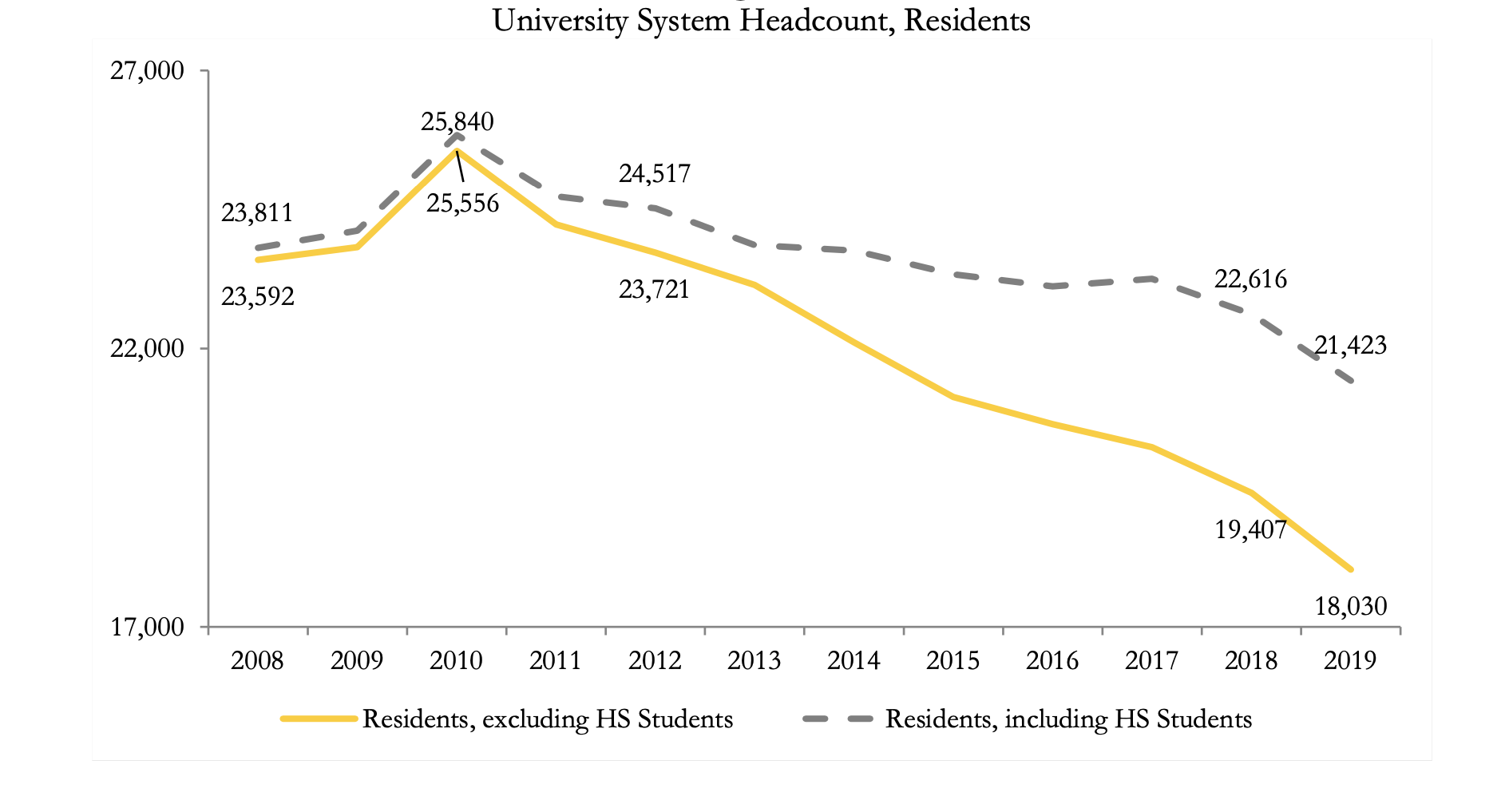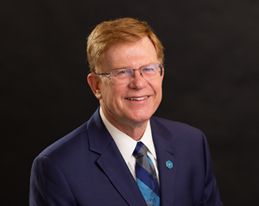Total enrollment is on a steady decline in the public university system in South Dakota, forcing higher education officials to seek new sources of revenue, realign infrastructure and potentially cut programs or faculty positions.
At South Dakota State University in Brookings — the state school with the highest enrollment — an unexpected 4% decline in enrollment in the fall of 2019 caused university officials to begin working on a plan likely to include cutting faculty positions. The SDSU Faculty Senate has been discussing the issue for months, said David Clay, the organization’s president.
“Much of the faculty are worried about their jobs,” Clay said.
Final decisions about any cuts aren’t expected until the spring of 2020, he said.
Any cuts will be doubly frustrating because the enrollment declines largely are due to circumstances outside of faculty members’ and even university officials’ control, Clay said. “It’s like a perfect storm,” he said.
Since 2010, overall enrollment at South Dakota public universities has fallen by more than 5%, or by almost 2,000 students. Long-term economic and demographic changes, as well as higher on-time graduation rates, are driving what has been a slow decline in the number of South Dakota residents seeking college degrees at the state’s six public universities.
Some schools have seen enrollment increases, but those have been offset by larger losses at other universities, with SDSU seeing the largest percentage decline. The number of state residents enrolled part time or full time at the state’s universities has fallen even faster. Between 2010 and 2019, resident enrollment fell from 25,800 to 21,400, a drop of around 17%.
The decline in overall enrollment represents a loss of millions of dollars in revenue for the university system which gets roughly 60% of its funding from tuition and fees.
State support for higher education, meanwhile, has largely remained flat outside of one-time funding for specific projects. As enrollment continues to decline, universities are being forced to rethink programs, staffing and teaching methods, said Paul Beran, executive director of the state Board of Regents.

“The reality is that every (university) president is looking at ways that they’re going to become more efficient,” Beran said. “They’re looking at ways to take really hard looks at their workforce in three areas — staff, administration and faculty.”
At least part of the decline in enrollment is due to economic expansion following the end of Great Recession of 2008, Beran said. During recessions, traditional students tend to stay in school longer in an effort to beef up resumes while non-traditional students enroll at higher rates because jobs are more scarce and require new skills. South Dakota’s public university system started to see a recession-inspired enrollment spike in 2010 when the system headcount jumped from 33,779 in 2009 to 36,440, Beran said.
South Dakota isn’t alone when it comes to college enrollment declines. National estimates have pegged the drop in four-year public college enrollments at about 7% between 2010 and 2017. Data compiled by the non-profit National Student Clearinghouse Research Center show a nationwide 1.3% decline in college and tech school enrollments between 2018 and 2019.
The news isn’t all bad. Enrollment figures for fall 2019 in South Dakota show a system-wide head count of 34,520, higher than the system’s pre-recession headcount, Beran said. The indication, he said, is that the system has been able to sustain growth over several decades despite the recent downturn.
“We actually had an increase … if you take the bubble out,” Beran said
Another issue South Dakota universities are grappling with is that there are fewer young South Dakotans to recruit into college. Demographic data compiled by the Western Interstate Commission on Higher Education — a partnership between 15 western states and two U.S. territories focused on helping university systems share resources — shows that South Dakota went from graduating around 9,500 high school seniors in the early 2000s to graduating around 8,500 in 2019. Other Great Plains states have seen similar trends, the data show. The population of high school graduates in South Dakota is, however, projected to grow over the next decade.
In effect, South Dakota’s universities have been competing regionally for fewer potential students and as the growth in costs outpaces the growth in state support, they are rapidly losing one of their chief advantages — lower prices. The total cost of a degree from a South Dakota university is low compared to the rest of the country. But because state support has lagged, students actually end up paying more for their degree than students in all but seven other states.
Low-income South Dakotans have been priced out of college, Beran said. In 2011 the state’s universities enrolled more than 70% of students who qualified for free and reduced lunches at their high school and scored a 22 on the ACT. In 2019, just 51% of those students enrolled in college.
“We’re producing education efficiently … but our students are are paying a higher percentage of that cost,” Beran said.
Declining enrollment and the tighter budgets that result will create more stress and hardship at the state’s universities. But it may also give administrators a chance to make big changes in how they deliver education, Beran said.
“My theory is never waste a crisis. And because now you’ve got an opportunity to actually make changes, under the guise of fiscal realities … and reshift your resources into areas that you really need to shift them to. And it’s hard to do that in times of prosperity.”
Enrollment by university from 2010 to 2019
Here is a look at student enrollment at the six public universities in South Dakota over the past decade, including in the system overall.
School Fall 2010 Fall 2019 % change
BHSU 4,722 3,958 – 18.3%
DSU 3,101 3,268 + 5.4%
NSU 3,296 3,427 + 4.0%
SDSMT 2,354 2,529 + 7.4%
SDSU 12,816 11,518 – 10.1%
USD 10,251 9,920 – 2.3%
TOTAL 36,440 34,520 – 5.3%
Source: South Dakota Board of Regents
“The reality is that every (university) president is looking at ways that they're going to become more efficient. They're looking at ways to take really hard looks at their workforce in three areas - staff, administration and faculty." -- Paul Beran, executive director of the South Dakota Board of Regents
The internet and efficiency
One opportunity South Dakota’s universities are already beginning to embrace is a dramatic increase in the popularity of online learning. Increasingly, students are opting to take their classes online, even if they’re living in a dorm on a university campus, said Black Hills State University President Laurie Nichols.
“What we’re learning is that those students love taking courses online,” she said. “With online classes, you can get around course scheduling conflicts and they’re easier to fit into work schedules.”
If not for strong enrollment in online classes, university headcounts would be down closer to 10%. At Northern State University in Aberdeen, for example, online enrollment has risen nearly 60% since 2010 while on-campus enrollment has fallen 30%. At BHSU in Spearfish, on-campus enrollment fell by 32% between 2010 and 2019 but online enrollment held relatively steady with .3% growth. The good news for schools such as BHSU is that online courses, for the most part, aren’t any less expensive than taking a class in person, Nichols said.
High school students also have come to account for a significant portion of online college course enrollments thanks to South Dakota’s dual-credit program. The program uses tax dollars to help pay for high school students to earn college credits through online courses that also count toward high school graduation requirements. The number of high school students enrolled in on-line college courses through the South Dakota Board of Regents has increased from 721 in 2013 to more than 3,400 in 2019.
“That’s an area that we have really jumped into with both feet the past couple of years. We’ve really enhanced our dual-credit opportunities for students. And we’ve seen some really great growth in that area. And really, that is all about time to degree and lowering the cost of education,” said Sydney Chapman, assistant director of financial aid at SDSU.
Still, SDSU has seen its headcount drop about 10% since 2010. In fall 2019, the regents reported that SDSU had seen a larger than expected 4% year-over-year decline in enrollment including drops in both on-campus and online enrollment. Such sharp declines bring new urgency to yearly planning efforts aimed at “right-sizing” the school’s course offerings and spending, said SDSU Provost Dennis Hedge.
“We do work very hard at South Dakota State to drive efficiencies throughout the organization as much as we possibly can,” Hedge said.
Faculty members worry that “right-sizing” will mean students lose out on the well-rounded education they are promised. Clay, the SDSU faculty senate president said cuts usually target smaller programs with lower enrollments, many of which still provide courses for students who don’t major in the subject but still benefit from learning about it.
“We need diversity in education, we need some of these low-enrollment programs,” said Clay. “People need to know about citizenship, they need to know how to write.”
Efforts to improve the university system’s efficiency, such as promoting dual credit, have likely contributed to the decline in enrollment. South Dakota’s public university students, some of whom are showing up on campus with nearly a full semester’s worth of credits, are graduating faster than they used to, Beran said.
The state Board of Regents has also developed programs to help students make better decisions about what to major in, which reduces the number of credits a student ends up taking before earning their degree. The Board of Regents also cut the number of credit hours required for most of its bachelor’s degree programs from 128 to 120. University systems around the U.S. have made the same move in order to cut the cost of their degrees and make their programs more efficient. Now many students are completing their required coursework one or two years earlier than students 10 years ago, Beran said.
“We’ve had a much better and stronger retention rate and a higher graduation rate. And so what that means is you have fewer students hanging around taking classes into their seventh, eighth year,” Beran said. “We’re making a very concerted effort to get them graduated four years.”
The problem is, with fewer students taking fewer credit hours and having a smaller pool of college bound students to recruit from, South Dakota’s universities have been forced to look beyond the state’s borders to boost enrollment.

Tech programs attracting non-resident students
South Dakota’s universities have spent years stepping up efforts to recruit students from outside the state as a way to offset the decline in resident high school graduates. Their efforts are bearing fruit. The number of nonresident students in the university system has increased more than 23%, rising from 10,600 in 2010 to 13,097 in 2019.
At SDSU, the number of nonresident students has increased by 942. At USD, nonresident enrollment is up by 632 students and the number of nonresident students climbed by 638 at Dakota State University in Madison, an increase of more than 94% over 10 years. At the South Dakota School of Mines & Technology in Rapid City, nonresident enrollment was up 43%, or 425 students. Only Northern State University has shown a decrease in nonresident enrollments.
Despite rising costs and largely stagnant state support South Dakota universities still offer nonresident students a pretty good deal price-wise compared to many states, said SDSM&T interim provost Lance Roberts. The School of Mines has another advantage in that the school has routinely been rated in national media as having the best bang for the buck when it comes to degrees in science, technology, engineering and math, Roberts said. At one point, the school’s graduates were reportedly earning higher starting salaries than some Ivy League graduates.
Such flattering national media attention helps SDSM&T recruiters in Colorado and Minnesota appeal to science and engineering minded students, Roberts said. Enrollment at SDSM&T has actually increased 7.5% since 2010.
“We have a good product, we focus on STEM fields and there are a lot of jobs out there in those fields and starting salaries are really good,” he said.

Dakota State University, the only other state university to see its enrollment rise over the last decade, has a similar set of advantages, said Jim Moran, DSU provost.
“We’ve kind of become the designated technology university in South Dakota,” Moran said.
Specialized programs in cyber security, partnerships with federal agencies such as the Department of Defense and the National Security Agency as well as a new business incubation center combined with comparatively low costs have spurred a 5% increase in DSU’s enrollment. Enrollment growth at the university has actually outpaced the growth of university housing, Moran said.
“We see the future as very bright,” he said.



